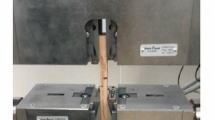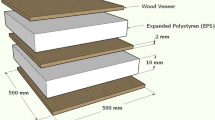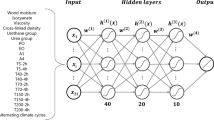Abstract
Veneer drying is one of the most important stages in the manufacturing of veneer-based composites such as plywood and laminated veneer lumber. Due to the high drying costs, increased temperatures are being used commonly in plywood industry to reduce the overall drying time and increase capacity. However, high drying temperatures can alter some physical, mechanical and chemical characteristics of wood and cause some drying-related defects. In this study, it was attempted to predict the optimum drying temperature for beech and spruce veneers via artificial neural network modeling for optimum bonding. Therefore, bonding shear strength values of plywood panels manufactured from beech and spruce veneers dried at temperatures of 20, 110, 150 and 180 °C were obtained experimentally. Then, the intermediate bond strength values based on veneer drying temperatures were predicted by artificial neural network modeling, and the values not measured experimentally were evaluated. The optimum drying temperature values that yielded the highest bonding strength were obtained as 169 °C for urea formaldehyde and 125 °C for phenol formaldehyde adhesive in beech plywood panels, while 162 °C for urea formaldehyde and 151 °C for phenol formaldehyde in spruce plywood panels.






Similar content being viewed by others
References
Avramidis S, Iliadis L (2005) Wood-water sorption isotherm prediction with artificial neural networks: a preliminary study. Holzforschung 9(3):336–341
Aydin I, Colakoglu G (2005) Formaldehyde emission, surface roughness, and some properties of plywood as function of veneer drying temperature. Drying Technol 23:1107–1117
Aydin I, Colakoglu G (2008) Variations in bending strength and modulus of elasticity of spruce and alder plywood after steaming and high temperature drying. Mech Adv Mater Struct 15:371–374
Baldwin RF (1995) Veneer drying and preparation. In Plywood and Veneer-Based Products, Miller Freeman Books, San Francisco
Castellani M, Rowlands H (2008) Evolutionary feature selection applied to artificial neural Networks for wood-veneer classification. Int J Prod Res 46(11):3085–3105
Ceylan I (2008) Determination of drying characteristics of timber by using artificial neural networks and mathematical models. Drying Technol 26(12):1469–1476
Christiansen AW (1990) How overdrying wood reduces its bonding to phenol formaldehyde adhesives: a critical review of the literature, part I physical responses. Wood Fiber Sci 22(4):441–459
Cook DF, Chiu CC (1997) Predicting the internal bond strength of particleboard, utilizing a radial basis function neural network. Eng Appl Artif Intell 10(2):171–177
Cook DF, Ragsdale CT, Major RL (2000) Combining a neural network with a genetic algorithm for process parameter optimization. Eng Appl Artif Intell 13:391–396
Currier RA (1958) High drying temperatures–do they harm veneer? Forest Prod J 8(4):128–136
Drake PR, Packianather MS (1998) A decision tree of neural networks for classifying images of wood veneer. Int Adv Manuf Technol 14:280–285
Esteban LG, Fernandez FG, Palacios PD, Romero RM, Cano NN (2009) Artificial neural networks in wood identification: the case of two Juniperus species from The Canary Islands. IAWA J 30(1):87–94
Esteban LG, Fernandez FG, Palacios P (2010) Prediction of plywood bonding quality using an artificial neural network. Holzforschung 65(2):209–214
FAO (1990) Energy conservation in the mechanical forest industries: FAO forestry paper. Food and Agriculture Organization of The United Nations, Rome
Fengel D, Wegener G (1989) Wood chemistry. Walter de Gruyter, Berlin, Ultrastructure
Fernández FG, Esteban LG, Palacios P, Navarro N, Conde M (2008) Prediction of standard particleboard mechanical properties utilizing an artificial neural network and subsequent comparison with a multivariate regression model. Investigación agraria: Sistemas y recursos forestales. 17(2):178–187
GuangSheng C, Li G (2008) Comparison of forecasting methods for wood quality. J Northeast For Univ 36(6):30–31
Khalid M, Lee ELY, Yusof R, Nadaraj M (2008) Design of an intelligent wood species recognition system. Int J Simul Syst Sci Technol 9(3):9–19
Lehtinen M, Syrjänen T, Koponen S (1997) Effect of drying temperature on properties of veneer. Helsinki University of Technology, Laboratory of Structural Engineering and Building Physics, Finland
Long W, Rice RW (2008) Detection of structural damage in medium density fiberboard panels using neural network method. J Compos Mater 42:1133–1145
Lutz JF (1978) Wood Veneer: log selection, cutting, and drying: U.S. Department of Agriculture, Tech Bull No. 1577
Mansfield SD, Iliadis L, Avramidis S (2007) Neural network prediction of bending strength and stiffness in western hemlock (Tsuga heterophylla Raf.). Holzforschung 61(6):707–716
Ozsahin S (2012) The use of an artificial neural network for modeling the moisture absorption and thickness swelling of oriented strand board. Bio Resour 7(1):1053–1067
Packianather MS, Drake PR (2004) Modelling neural network performance through response surface methodology for classifying wood veneer defects. Proceedings of the Institution of Mechanical Engineers. Part B: J Eng Manuf 218 (4):459–466
Rice RW (1988) Mass transfer, creep and stress development during the drying of red oak: Ph.D. Dissertation, Virginia Polytechnic Institute and State University, Blacksburg Virginia
Sagiroglu S, Besdok E, Erler M (2003) Applications of artificial intelligence in engineering-1: artificial neural networks. UFUK Publishing House, Turkey
Samarasinghe S, Kulasiri D, Jamieson T (2007) Neural networks for predicting fracture toughness of individual wood samples. Silva Fennica 41(1):105–122
Sernek M (2002) Comparative analysis of inactivated wood surfaces, Ph.D. Thesis, Faculty of The Virginia Polytechnic Institute and State University, Blacksburg, Virginia
Shen KC (1958) The effects of dryer temperature, sapwood and heartwood, and time elapsing between drying and gluing on the gluing properties of engelmann spruce veneer, Msc Thesis, Faculty of Forestry The University of British Columbia
Suchsland O, Stevens RR (1968) Gluability of southern pine veneer dried at high temperatures. Forest Prod J 18(1):38–42
Tanaka T, Tanaka T, Nagao H, Kato H (1996) A preliminary investigation on evaluation of strength of soft wood timbers by neural network. 10th International symposium on nondestructive testing of wood August 26–28, pp 323–329
Theppaya T, Prasertsan S (2004) Optimization of rubber wood drying by response surface method and multiple contour plots. Drying Technol 22(7):1637–1660
Tou JY, Lau PY, Tay YH (2007) Computer vision-based wood recognition system, proceedings of international workshop on advanced image technology (IWAIT). Bangkok, Thailand, pp 197–202
Walker JCF (2006) Primary wood processing, 2nd edn. Springer, The Netherlands
Wu H, Avramidis S (2006) Prediction of timber kiln drying rates by neural networks. Drying Technol 24:1541–1545
Zhang D, Sun L, Cao J (2006a) Modelling of temperature-humidity for wood drying based on time-delay neural network. J For Res 17(2):141–144
Zhang J, Cao J, Zhang D (2006b) ANN-based data fusion for lumber moisture content sensors. Trans Inst Meas Control 28(1):69–79
Author information
Authors and Affiliations
Corresponding author
Rights and permissions
About this article
Cite this article
Ozsahin, S., Aydin, I. Prediction of the optimum veneer drying temperature for good bonding in plywood manufacturing by means of artificial neural network. Wood Sci Technol 48, 59–70 (2014). https://doi.org/10.1007/s00226-013-0583-2
Received:
Published:
Issue Date:
DOI: https://doi.org/10.1007/s00226-013-0583-2




